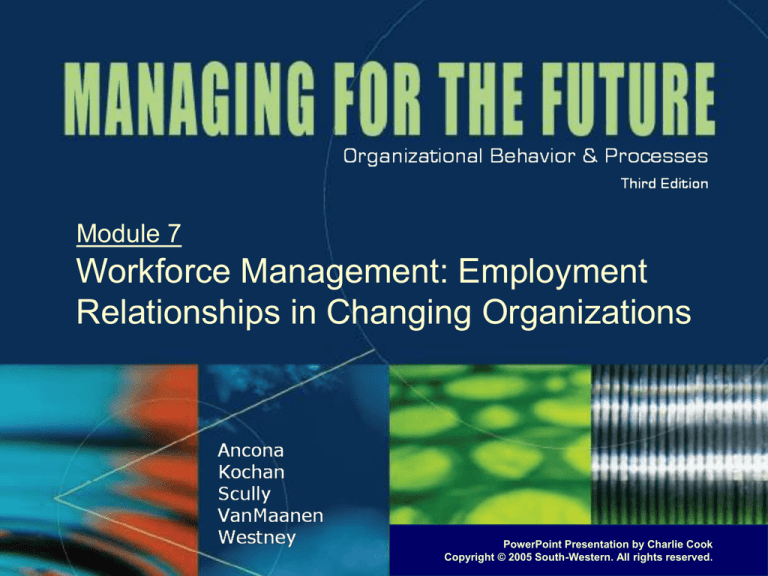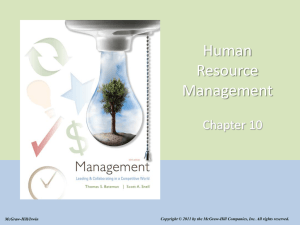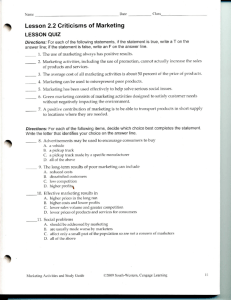
Module 7
Workforce Management: Employment
Relationships in Changing Organizations
PowerPoint Presentation by Charlie Cook
Copyright © 2005 South-Western. All rights reserved.
Overview
• Old model of employment:
Bounded, hierarchical, fixed, homogeneous, and local
• New model of employment:
Networked, flat, flexible, diverse, and global
Overview
Copyright © 2005 South-Western. All rights reserved.
7–2
Overview (cont’d)
• As organizations move from bounded to
networked
Plus: Opportunities arise for collaboration with new
colleagues across boundaries
Minus: Careers will involve a patchwork of jobs in
different organizations
Question: How can managers maintain loyalty
between employees and companies and between
employees and teams as memberships are in flux?
Overview
Copyright © 2005 South-Western. All rights reserved.
7–3
Overview (cont’d)
• As organizations move from hierarchical to flat
Plus: More employees at all levels have access to
decision-critical information
Minus: Fewer vertical promotion paths and confusion
about what “career success” means
Question: How can managers motivate employees
without the traditional promise of promotions?
Overview
Copyright © 2005 South-Western. All rights reserved.
7–4
Overview (cont’d)
• As organizations move from fixed to flexible
Plus: Employees have a range of ways to organize the
time and space in which they work
Minus: It may be difficult to coordinate the efforts of
employees working under different arrangements
Question: How can managers balance flexibility and
coordination?
Overview
Copyright © 2005 South-Western. All rights reserved.
7–5
Overview (cont’d)
• As organizations move from homogeneous to
diverse
Plus: A range of new approaches to work will be
stimulated as new groups are included
Minus: Differences may breed contests between
groups
Question: How can managers be responsive to diverse
constituencies in ways that respect differences but are
also fair and consistent?
Overview
Copyright © 2005 South-Western. All rights reserved.
7–6
Overview (cont’d)
• As organizations move from local to global
Plus: New ways to include multiple stakeholders will
be added to the menu
Minus: Range of choices will make it more challenging
to present any one choice as legitimate
Question: How can managers learn from different
global examples?
Overview
Copyright © 2005 South-Western. All rights reserved.
7–7
“Old” Versus “New”
Employment Relationship
• From World War II through the 1970s
Sustained period of shared prosperity
Many employees worked in “internal labor markets”
Long-term employment with one employer
Internal advancement up a company job ladder
Well-defined jobs linked in a progression that defined a career
Individual compensation based on merit, seniority
• From the mid-1970s to the mid-1990s
Productivity growth slowed
Real wages stagnated
Restructuring produced significant white-collar layoffs
Class Note: Managing a Changing Workforce in Turbulent Times
Copyright © 2005 South-Western. All rights reserved.
7–8
“Old” Versus “New”
Employment Relationship (cont’d)
• Today more jobs are filled by turning to the
external market rather than promoting from within
• The new employment relationship is “market
mediated” rather than an internal labor market
process
Class Note: Managing a Changing Workforce in Turbulent Times
Copyright © 2005 South-Western. All rights reserved.
7–9
“Old” Versus “New”
Employment Relationship (cont’d)
• Employment security
From the 1950s to the 1970s, U.S. employees and
employers expected employment relationship to be
long term
During the 1980s, this “implicit contract” changed;
large companies began to lay off employees as part of
restructuring efforts
At the same time, these companies were also hiring
new employees
Class Note: Managing a Changing Workforce in Turbulent Times
Copyright © 2005 South-Western. All rights reserved.
7–10
“Old” Versus “New”
Employment Relationship (cont’d)
• Reasons for restructuring and reorganizing:
Globalization and international competition
Changing technologies
Easier to hire new workers than retrain employees
The wage bill was the first to be cut
Getting rid of “dead wood”
Competition prompted companies to do more with
fewer people
Declining union power
Subcontractors, temporary workers, outsourcing
Class Note: Managing a Changing Workforce in Turbulent Times
Copyright © 2005 South-Western. All rights reserved.
7–11
“Old” Versus “New”
Employment Relationship (cont’d)
• Advancement
Traditionally, employees spent a career advancing
within a company
Flattening of job ladders resulted in fewer or different
types of advancement
Lateral advancement or advancement up the levels of
a skill set are now common
Class Note: Managing a Changing Workforce in Turbulent Times
Copyright © 2005 South-Western. All rights reserved.
7–12
“Old” Versus “New”
Employment Relationship (cont’d)
• Jobs and compensation:
Traditional organization chart with strict hierarchical
links has been replaced by a web of interconnecting
tasks and relationships
Individual jobs are increasingly multiskilled
Employees are encouraged to cross-train and learn a
variety of tasks to allow for job rotation
Compensation systems need to shift from individual
incentives tied to specific job titles to rewards for
learning new skills and working effectively in teams
Class Note: Managing a Changing Workforce in Turbulent Times
Copyright © 2005 South-Western. All rights reserved.
7–13
Changes in the Distribution of the U.S. Labor
Force by Subgroup, 1994–2005
(number in thousands, percent in parentheses)
Class Note: Managing a Changing Workforce in Turbulent Times
Source: From Judith Friedman and Nancy DiTomaso, “Myths About Diversity; What Managers Need to Know
About Changes in the U.S. Labor Force.” Copyright © 1996, by The Regents of the University of California.
Reprinted from the California Management Review, vol. 38, no. 4. By permission of the Regents.
Copyright © 2005 South-Western. All rights reserved.
* Does not add up to zero due to rounding error.
Figure 7.1
7–14
Flexibility
• Demand for flexibility in work often traced to
entrance of women into paid workforce
• Rise of women into higher organizational
positions prompted new dialogues on balancing
work and family
• Dialogue expanded from “women’s issue” to
include:
Parental leave time
Flexible time arrangements for caring for parents or ill
family members
Class Note: Managing a Changing Workforce in Turbulent Times
Copyright © 2005 South-Western. All rights reserved.
7–15
Flexibility (cont’d)
• Flexibility choices:
Flexible space
Telecommuting, virtual offices
Flexible time and allocation of tasks
Flex time, part-time work, job sharing
Flexible career paths
Challenge is to overcome fear that flexible work arrangements
will damage career opportunities
Flexible workforce size and firm boundaries
Reliance on temporary workers may result in loss of employee
loyalty and commitment
Class Note: Managing a Changing Workforce in Turbulent Times
Copyright © 2005 South-Western. All rights reserved.
7–16
Human Assets and 21st Century
Organizational Forms
• Labor costs are normally the largest variable cost
in most firms, so employee costs are tightly
controlled
• When employees leave, they may take significant
portions of a firm’s assets (knowledge and
clients) with them
• Organizations need to find ways to retain critical
knowledge workers
Class Note: Managing a Changing Workforce in Turbulent Times
Copyright © 2005 South-Western. All rights reserved.
7–17
Contrasting Assumptions in Twentiethand Twenty-First-Century Organizations
Class Note: Managing a Changing Workforce in Turbulent Times
Source: Thomas A. Kochan, Wanda Orlikowski, and Joel Cutcher Gershenfeld, “Beyond McGregor’s Theory Y:
Human Capital and Knowledge Work in the 21st Century Organization,” MIT Sloan School of Management, 2002.
Copyright © 2005 South-Western. All rights reserved.
Figure 7.2
7–18
The Evolving Focus of Strategy
The Press: Building Competitive Advantage Through People
Copyright © 2005 South-Western. All rights reserved.
7–19
The Evolving Role of Human Resources
The Press: Building Competitive Advantage Through People
Copyright © 2005 South-Western. All rights reserved.
7–20





